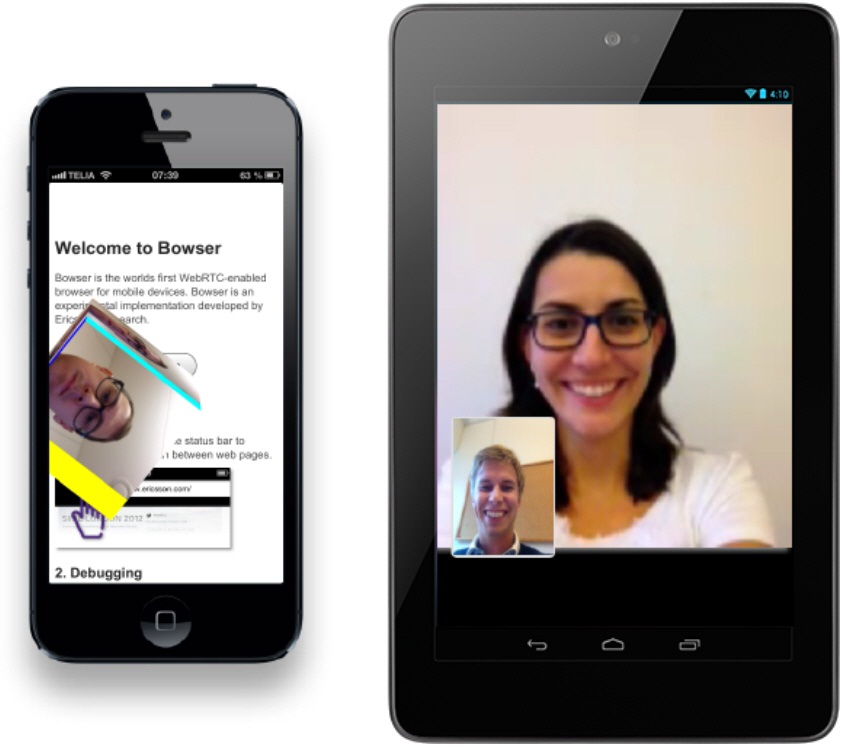Several weeks ago, Ericsson Research announced the world’s first WebRTC-enabled browser for mobile devices, called “Bowser.” WebRTC, as most know by now, is an emerging video communications standard with ongoing development work within the World Wide Web Consortium (W3C) and the Internet Engineering Task Force (IETF). The goal is to develop a standard, interoperable approach to real-time communication (RTC) using audio and video in Web browsers without the need for any plug-ins.
Amazingly, there are lots of other Bowsers we might become confused with. First, there is the Bowser (also known as King Koopa) of Mario Brothers video game fame. There is also the old Sha Na Na doo wop guy Bowzer (who's name is more often than not misspelled as Bowser). Then there is an ancient Internet Relay Chat (IRC) client dating back to the 1990s that was called Bowser. The bottom line though is that we aren't talking about any of these, even though IRC may seem somewhat related (it isn't).
Ericsson Research is heavily involved in the standardization of WebRTC, and has been developing prototype implementations of the evolving standard for more than two years. With the newly released Bowser, developers can now begin to experiment with real-time audio and video functionality in mobile Web applications. Mobile, we believe, is critical to the advancement of WebRTC, and Bowser takes things specifically into the mobile realm. Desktop-based WebRTC is more real and less experimental, and we will probably see a fully developed, stable and complete set of browser implementations within the next 12 months.
Mobile browsers, such as mobile Safari on iPhone, typically display <video> elements only in full screen. This severely limits the UI of your apps, especially when designing video communication apps using WebRTC. Bowser goes beyond that and allows developers to fully customize and manipulate <video> elements using CSS and JavaScript. Keep CSS and Javascript in mind - we'll return to them shortly.
Kristofer Dovstam, master researcher at Ericsson Research, says, “We believe WebRTC is a very important part of future communication solutions in our industry, and are excited to provide developers with the first version of our experimental WebRTC-enabled mobile browser.”
Android and iOS users can download Bowser, although quite honestly there is nothing one can actually do with it as far as WebRTC goes. One can sit on a specific page (for reference it is http://getbowser.appspot.com/welcome) that allows a user to turn on the front-facing camera (ala Skype and Facetime), and then one can even take this camera image and spin it and bounce it around on a cube on the mobile device screen, but that's pretty much it for us end-users. There is also a short demo video available if you don't want to go through the trouble of downloading Bowser. We ourselves were not able to get the menu to pop up that allows one to make a video call.

The browser is clearly labeled as experimental and for testing only. In some situations it may crash, so don't use it for any critical communication. You can actually get to the Web page listed via your desktop as well, but there isn't anything there other than a page of static text.
WebRTC and the HTML5 Standard
Last week, at the first ever WebRTC Conference, Plantronics CTO Joe Burton delivered a keynote address. Burton makes note of the fact that the major communications services - for example Skype, Jabber and Lync - require really heavy duty development capabilities that include advanced, low-level video processing knowledge and C++ skills. WebRTC's inclusion in HTML5 will entirely remove this requirement. Burton - and Plantronics itself - are now on a mission to make it clear that such sophisticated communications capabilities can now be built through the far simpler use of HTML5 and the emerging WebRTC protocols - which require no more advanced skills than knowing one's way around HTML, JavaScript and CSS.
Essentially, it is the very same argument one puts forth on the issues of building native mobile apps vs. building mobile and Web apps in HTML5. Anyone with a solid knowledge of basic Web development skills can create or modify a communications application.
Both Burton personally and Plantronics as a company are now also calling for the WebRTC protocols to be folded into the HTML5 specification itself. That is certainly an interesting perspective - though we're not sure however if doing so will bring a stable and final WebRTC set of standards to the table faster than if it remains outside of HTML5. Plantronics position is that the two are so tightly coupled that they should be merged into one single HTML5 standard. Plantronics has, among other useful tools, released sample source code that shows how WebRTC can be used to build applications that make use of Plantronics wireless headsets (so we can also add "wearable" and mobile technology to the overall mix of things WebRTC touches).
Burton also notes that while WebRTC will certainly help to bring such tried and true enterprise services as customer support into the modern realm of HTML5 Web browsers - and we'll add here that this means specifically without the need for any browser software plugins (as all real time chat programs now require a user to do), this isn't what excites him the most. Rather, Burton is looking ahead to a whole collection of new things we haven't yet discovered or put a real face to yet.
WebRTC and HTML5 point us in the right directions, at least for the desktop. With Bowser in hand as well, developers are now equipped to also begin experimenting for real within the mobile realm as well.
We ourselves are ready to go whole hog into wireless, WebRTC-enabled Ray Ban Wayfarer eyewear! It's all just around the corner.
